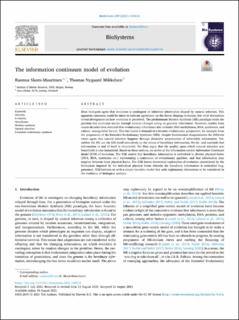| dc.description.abstract | Most biologists agree that evolution is contingent on inherited information shaped by natural selection. This apparent consensus could be taken to indicate agreement on the forces shaping evolution, but vivid discussions reveal divergences on how evolution is perceived. The predominant Modern Synthesis (MS) paradigm holds the position that evolution occurs through random changes acting on genomic inheritance. However, studies from recent decades have revealed that evolutionary inheritance also includes DNA-methylation, RNA, symbionts, and culture, among other factors. This has fueled a demand of a broader evolutionary perspective, for example from the proponents of the Extended Evolutionary Synthesis (EES). Despite fundamental disagreements the different views agree that natural selection happens through dissimilar perpetuation of inheritable information. Yet, neither the MS, nor the ESS dwell extensively on the nature of hereditary information. We do - and conclude that information in and of itself is immaterial. We then argue that the quality upon which natural selection acts henceforth is also immaterial. Based on these notions, we arrive at the information-centric Information Continuum Model (ICM) of evolution. The ICM asserts that hereditary information is embedded in diverse physical forms (DNA, RNA, symbionts etc.) representing a continuum of evolutionary qualities, and that information may migrate between these physical forms. The ICM leaves theoretical exploration of evolution unrestricted by the limitations imposed by the individual physical forms wherein the hereditary information is embedded (e.g. genomes). ICM bestows us with a simple heuristic model that adds explanatory dimensions to be considered in the evolution of biological systems. | en_US |
